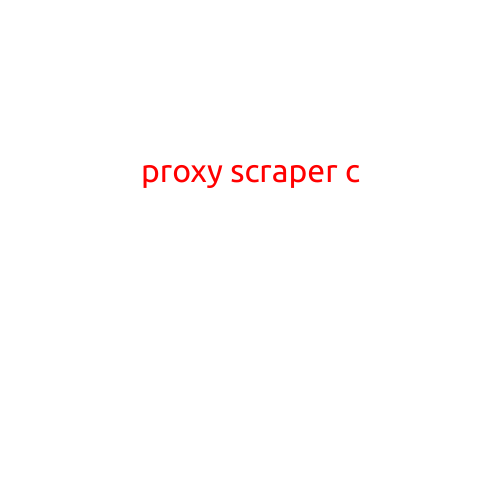
Proxy Scraper C: A Comprehensive Guide to Automating Web Data Extraction
The art of web scraping has become a vital component of modern data analysis. With the constant influx of data on the web, it’s essential to find efficient ways to extract and process this information. In this article, we’ll delve into the world of Proxy Scraper C, a powerful programming language used for creating high-performance web scrapers.
What is Proxy Scraper C?
Proxy Scraper C is a C programming language variant specifically designed for scraping web data. It’s an extension of the traditional C language and is optimized for web scraping tasks. Proxy Scraper C provides a set of utilities and libraries that simplify the process of extracting data from websites, handling HTTP requests, and parsing HTML content.
Benefits of Using Proxy Scraper C
- Faster Execution: Proxy Scraper C is built for speed, allowing your web scraper to process data at incredible rates. This is particularly useful when dealing with massive datasets or time-sensitive information.
- Powerful Handling of HTTP Requests: Proxy Scraper C includes a robust set of libraries and utilities for handling HTTP requests, including user agent rotation, cookie management, and robust error handling.
- Efficient Proxy Rotation: Proxy Scraper C streamlines the process of rotating proxies, ensuring that your web scraper remains anonymous and protected while extracting data.
- Scalability: Proxy Scraper C is designed to scale with your data extraction needs, allowing you to tackle large-scale web scraping projects without compromising performance.
How to Get Started with Proxy Scraper C
Before diving into the world of Proxy Scraper C, you’ll need to:
- Install the Proxy Scraper C compiler: The official compiler can be downloaded from the Proxy Scraper C website.
- Familiarize yourself with C programming basics: While Proxy Scraper C is designed to simplify web scraping tasks, a basic understanding of C programming is still required.
- Choose a web scraping library: Proxy Scraper C comes with a range of built-in libraries, such as libcurl, to simplify HTTP requests and HTML parsing.
Example Code for Proxy Scraper C
Below is an example of a basic Proxy Scraper C code snippet that extracts data from a simple web page:
#include <proxy_scraper.h>
#include <curl.h>
int main() {
// Initialize the CURL library
CURL *curl;
curl_global_init(CURL_GLOBAL_DEFAULT);
curl = curl_easy_init();
// Set the URL to scrape
curl_easy_setopt(curl, CURLOPT_URL, "https://example.com");
// Set the user agent (optional, but recommended for anonymity)
curl_easy_setopt(curl, CURLOPT_USERAGENT, "Mozilla/5.0");
// Perform the request and get the HTML response
CURLcode res = curl_easy_perform(curl);
if (res != CURLE_OK) {
fprintf(stderr, "cURL error: %s\n", curl_easy_strerror(res));
return 1;
}
// Parse the HTML content using libxml2
xmlDoc *doc = xmlReadMemory(curl_easy_strerror(res), 4096, NULL, NULL, BAD_CAST "utf-8");
if (doc == NULL) {
fprintf(stderr, "Failed to parse HTML\n");
return 1;
}
// Extract the desired data
xmlNode *root = xmlDocGetRootElement(doc);
xmlNode *item = xmlFirstElementChild(root);
while (item != NULL) {
// Extract data from each item node
printf("%s ", xmlNodeGetContent(item));
item = xmlNextElementSibling(item);
}
// Release resources
xmlFreeDoc(doc);
curl_easy_cleanup(curl);
curl_global_cleanup();
return 0;
}
Conclusion
Proxy Scraper C is a powerful tool for automating web data extraction. Its speed, efficiency, and robust error handling make it an ideal choice for large-scale data scraping projects. By following this guide and experimenting with the language, you’ll be well on your way to mastering Proxy Scraper C and unlocking the full potential of web scraping.





